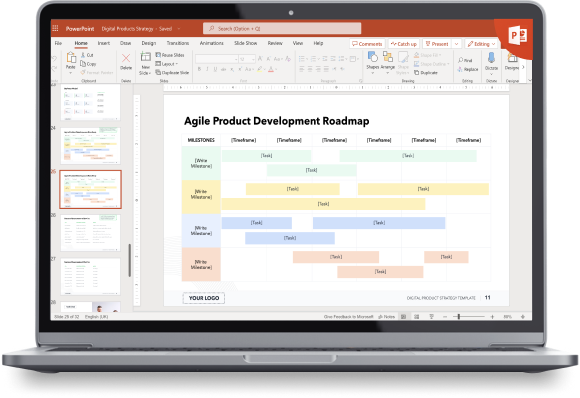- Strategy
- 16 min read
- July 2023
11-Step Framework for Digital Product Development
Imagine being an entrepreneur standing at the edge of the expansive digital landscape, ready to plunge into the world of innovation with a groundbreaking digital product idea.
The glimmering lights of opportunities seem inviting, yet the journey is often filled with challenges that can easily derail even the most promising ideas.
Venturing into the digital sphere comes with an array of complexities. Deciding on the product's core functionality, keeping up with the ever-evolving technology stack, dealing with unforeseen development issues, understanding the target market's ever-changing needs, and ensuring a superior user experience are just a few hurdles that lie ahead.
In such a scenario, having a structured and robust digital product development framework can be the guiding beacon, illuminating the path to successful product deployment.
This framework can
- provide a clear roadmap
- outline each critical step from ideation to product launch and beyond
- ensure development teams stay on the right track throughout the digital product development journey
This article will explore a tried and tested 11-step digital product development framework that can turn your raw, innovative idea into a successful digital product.
Whether you're a startup venturing into the digital landscape for the first time or an established company looking to expand your digital portfolio, this guide will help you navigate the complex terrain of digital product development.
Importance of digital product development framework
In today's digital-centric market, where competition is fierce, a robust digital product development framework is essential for businesses that want to stay ahead of the curve.
Increased competition
With the rise of digital technology, the marketplace has become more crowded and competitive than ever. More companies are innovating and releasing new digital products, making it harder for individual businesses to stand out.
A robust digital product development framework becomes necessary in this landscape, not an option. The framework helps guide the development process, ensuring that the developed products are competitive and relevant to the target market.
This involves deeply understanding the market needs, competition, and technology trends to develop a product that provides unique value.
Rapid change
The digital landscape is constantly evolving due to technological advancements and changes in consumer behavior. To stay relevant, companies need to be agile, and this is where a robust product development framework comes into play.
A well-defined framework provides a structured approach to problem-solving, allowing organizations to quickly adapt to market changes. This could involve updating the product's features, changing the user interface, or even pivoting the entire product concept.
Furthermore, the framework aids in risk identification and mitigation, enabling companies to tackle potential issues head-on and avoid costly mistakes.
Higher customer expectations
Today's customers are tech-savvy and demand high-quality digital products that are easy to use and cater to their specific needs.
A strong product development framework helps companies meet these expectations by
- providing a clear process for understanding user requirements
- conducting usability testing
- incorporating user feedback into product design and development
This ensures the end product is user-friendly, meets customer needs, and provides a seamless user experience.
Reduced time-to-market
The longer it takes for a product to go from conception to market, the more it costs in terms of resources and potential revenue lost.
A robust framework can help reduce the time to market by providing a clear roadmap and a set of best practices to follow. This can involve:
- setting realistic timelines
- streamlining communication between different teams
- leveraging technology to automate certain processes
- maintaining a focus on key performance indicators (KPIs)
As a result, products can be launched swiftly, providing an edge in the fast-paced digital market.
Improved decision-making
Developing a digital product involves making numerous decisions - from the features to include to the design elements to use to the marketing strategies to implement.
A robust digital product development framework supports better decision-making by providing a structured approach to problem-solving.
By clearly outlining each process step, identifying potential risks, and providing guidance on mitigating these, the framework allows teams to make informed decisions that align with the product's goals and the organization's overall strategy.
What is digital product development?
Digital product development is the process of creating a new digital product from the ideation phase to launch. If you were to Google "Digital Product Development Framework," you would find a sea of information defining the process in various ways. This is because different organizations follow different approaches to developing digital products.
Regardless of whether you're a startup or an established organization, understanding the intricacies of the digital product development process is essential. Here are two critical points you should keep in mind:
The digital product development process can be complex; it starts with idea creation, identifying the problem, creating a solution to solve it, researching & planning, and much more.
The digital product development process is an ongoing cycle where you constantly update the product to meet market requirements.
Stages of the product development lifecycle
Before we proceed with the article, let's understand the development lifecycle for digital products. You will also observe that many of the terms used in these individual headings and subheadings spill over to one another because they eventually become part of your organization's digital product strategy.
Let's take a closer look at each stage of the digital product development lifecycle and provide some additional insight into how they contribute to a product's success:
1. Ideation
The ideation stage is the starting point for your product. It is where you generate innovative ideas and identify a problem that your product could potentially solve. During this stage, it is important to start with a clear goal and understand your target audience's needs. Embrace an iterative approach, be open to changes, and seek user feedback to refine your idea.
2. Research
Following ideation, it's crucial to thoroughly research your target market, competitors, and potential users' needs. Gathering as much information as you can allows you to validate your product idea and ensures there's a demand for it in the market. It's important to be objective and utilize the right research tools during this stage.
3. Design
After validating your idea, the next step is to translate your idea into a tangible design. This stage involves creating wireframes, mockups, and prototypes to visualize your product. Using user-centered design principles can help you create a functional and visually appealing product.
It's important to be creative and think outside the box during this stage to make your product stand out.
4. Development
During the development stage, your product idea starts to take shape. It's where coding, testing, and debugging happen. Picking the right technology stack for your product and being organized is crucial at this stage. This ensures the development process runs smoothly, allowing you to track progress and manage potential issues more effectively.
5. Testing
After the development stage, your product goes through rigorous testing. This includes functional, usability, and performance testing to ensure it works as expected. Feedback is invaluable during this stage, helping you identify bugs and make necessary improvements before launching the product.
6. Launch
Once your product has been thoroughly tested and refined, it's time to launch it. This stage involves marketing and promotional strategies to get your product in front of your target audience. It's at this stage that your product starts generating revenue.
7. Maintenance and support
Even after launching your product, offering ongoing maintenance and support is important. This could involve fixing bugs, adding new features, or enhancing the user experience based on feedback.
Keeping your product up-to-date and continuously improving is crucial to retaining users and maintaining its value in the market.
8. Retirement
Eventually, there may come a time when you need to retire your product. This could be due to various factors like technological changes, market demand, or the introduction of a new product.
During this stage, it's important to effectively communicate with your users about the changes and provide support as they transition.
The 11 Steps of a Successful Digital Product Development Framework
Important note: This framework emphasizes a cyclical process that ensures improvement and adaptation to the dynamic digital landscape.
1. Ideation
The journey of digital product development kicks off with the generation of innovative ideas. In this brainstorming stage, you identify issues you aim to address or needs you desire to fulfill with your product. A culture of creativity and openness is paramount here to cultivate truly revolutionary ideas.
2. Market research
Delving into the intricacies of your target market follows next. During this phase, you gather insights on potential users' expectations, their needs, prevalent market trends, and existing solutions. The knowledge gained refines your ideas, enabling you to zero in on what will truly add value and stand out in the market.
3. Idea validation
It's crucial to confirm the viability of your product idea, which is where idea validation steps in. It involves conducting surveys, customer interviews, and soliciting feedback from stakeholders and industry experts. The primary aim is to establish a market need for your product, preventing unnecessary expenditure of resources on a product that might not succeed.
4. Defining product requirements
Having validated your idea, it's time to discuss your product requirements. This task entails detailing what your product aims to achieve, its features, functionality, user flow, and the necessary technology stack for development. A comprehensive and clear set of product requirements is instrumental as it navigates your development team throughout the process.
5. Building a minimum viable product (MVP)
The MVP, a basic yet functional version of your product, is developed next. It's designed to tackle the core problem with minimum resources, equipped with enough features to satisfy early adopters and facilitate feedback for future iterations.
6. Testing the MVP
Once your MVP is ready, it undergoes testing with a select group of users. This process gauges its performance under real-world conditions, with user testing and feedback uncovering any existing issues or highlighting areas for improvement.
7. Iterating based on feedback
The feedback collected from testing the MVP paves the way for necessary modifications and enhancements to your product. This stage emphasizes an iterative process where testing and refining cycles repeat until the product meets user expectations.
8. Product development
With a refined MVP at hand, the course is set for full-scale product development. This phase involves integrating all planned features and functionalities, exhaustive testing, and readying the product for launch.
9. Product launch
Your product is ready for market launch following rigorous testing and quality assurance checks. It necessitates planning and executing effective marketing and sales strategies to successfully introduce your product to your target audience.
10. Collecting feedback post-launch
Post-launch feedback collection remains a vital step. This ongoing process provides insights into your product's market reception and identifies any additional features or improvements needed, ensuring that your product evolves based on user needs.
11. Continuous improvement
The cycle of digital product development doesn't conclude with the product launch. Digital products demand continual evolution to retain their relevance and value to users. Therefore, post-launch feedback should guide consistent enhancements and updates to your product.
Digital product management framework
Digital product management is a multi-disciplinary role that lies at the intersection of business, technology, and user experience. A digital product management framework is an organized method used by product managers to guide the planning, production, marketing, and improvement of digital products.
At its core, a digital product management framework is focused on maximizing the value of a digital product to both the company and its customers. It provides a structured approach for product managers to balance various factors such as market demand, customer needs, business strategy, and technological advancements.
Here's a generalized view of a digital product management framework:
1. Product strategy
The digital product strategy sets the direction for the product development process. This stage involves formulating the product vision, mission, and goals based on market trends, competitive analysis, user needs, and the organization's business objectives.
The product vision outlines what you aim to achieve in the long run, while the product goals are specific milestones that contribute to realizing this vision.
The product strategy also involves identifying the product's unique value proposition - what makes your product stand out from the competition. This could be anything from unique features to superior user experience or customer support.
2. Product planning
This stage involves translating the strategic vision into a detailed, actionable plan. The product roadmap is created, outlining the key features to be developed, their priority order, and estimated delivery timelines.
Product planning also includes the process of backlog management. The product backlog is a prioritized list of tasks or features that must be implemented.
This stage often involves complex decision-making, as product managers must consider feature value, development effort, user needs, and market trends to prioritize the backlog effectively.
3. Product development
During the product development stage, the product manager works closely with the development team to turn the product plan into reality. The product manager ensures that the development work aligns with the product strategy and user needs.
This stage involves defining user stories (detailed descriptions of product features from an end-user perspective), participating in agile development activities (like sprint planning, daily standups, and retrospectives), and managing stakeholder communication.
4. Product launch
Launching a product is a critical stage in the product management framework. This phase requires cross-functional collaboration, with the product manager coordinating with the marketing and sales teams.
Tasks include defining the go-to-market strategy, which outlines how the product will be sold and marketed, setting the pricing strategy, planning the product launch event or campaign, and arranging the customer support and service plan. The product manager must ensure all teams are ready and aligned for the product launch.
5. Product evaluation and improvement
Once the product is launched, the product manager needs to monitor its performance in the marketplace. They use key performance indicators (KPIs) to measure the product’s success, including metrics like user acquisition, user retention, revenue, customer satisfaction, and more.
The product manager also collects and analyzes user feedback, conducts usability tests, and uses various data analytics tools to gain insights into how users interact with the product.
These insights are then used to make necessary improvements to the product, thereby ensuring that it continues to meet user needs and business objectives. This stage emphasizes the importance of continuous learning and iterative development in product management.
Some crucial digital product development frameworks out there
The digital product development and management world is multi-faceted, employing various methodologies and frameworks to ensure successful product development. Here's a closer look at some of these key methodologies:
1. Lean development
The Lean Startup methodology is particularly valuable for startups and businesses in their early development stages. It centers on quick and efficient product development, minimizing waste, and achieving product-market fit as quickly as possible. The core principles are:
a. Build-Measure-Learn Cycle
It encourages building a minimum viable product (MVP) roadmap, measuring its performance in the market, and learning from these findings to refine the product or change the approach.
b. Customer development
Understanding your target market and their needs is essential. You can achieve this by regularly interacting with potential customers and seeking their feedback.
c. Validated learning
Rapid learning through experimentation and hypothesis testing is key to quickly validating whether a product or feature meets market needs.
2. Agile development
Agile development is a methodology often used in software development that emphasizes flexibility, customer satisfaction, and continuous improvement. The four core values of Agile are:
a. Individuals and interactions over processes and tools
The focus is on the team and its interactions rather than strictly adhering to tools or procedures.
b. Working software over comprehensive documentation
Delivering functional software is seen as more valuable than exhaustive documentation.
c. Customer collaboration over contract negotiation
Working closely with customers throughout the development process is prioritized over contractual agreements.
d. Responding to change over following a plan
Agile encourages flexibility and responsiveness to change instead of sticking rigidly to a pre-set plan.
3. Design Thinking
Design Thinking is a problem-solving approach that encourages empathy with users and iterative design to create innovative, user-centered solutions. It comprises five stages:
- Empathize: Understand users' needs, desires, and problems.
- Define: Clearly articulate the problem you're aiming to solve.
- Ideate: Generate a wide range of potential solutions.
- Prototype: Create a physical or digital representation of one or more of your ideas.
- Test: Evaluate the effectiveness of your solution by testing it with users and iterating based on feedback.
4. ADAPT Methodology®
ADAPT is a versatile methodology combining Lean Startup and Design Thinking elements. It advocates for a flexible, user-centered, and iterative approach to product development, with five guiding principles:
- Alignment: Ensuring all stakeholders and team members are unified in their understanding and objectives.
- Discovery: Constant learning and discovery about your product and users to inform development.
- Adaptation: Being open to change and adjusting your product or approach based on new insights.
- Prioritization: Concentrating efforts on the most valuable and impactful tasks.
- Teamwork: Fostering collaboration and unity within the team to drive product development.
Each methodology and framework serve different purposes, but they all share a common goal: to guide your digital product development stages.
Therefore, choosing the right approach largely depends on your specific context, such as the nature of your product, the characteristics of your team, and your users' expectations.
Maximizing success with a strong digital product development framework
Let's revisit the key takeaways from this article before we come to a conclusion
Ideation
Ideation is the vital first step in every product development framework. New product ideas are generated during this phase through brainstorming, market research, or talking to potential users.
It is essential to comprehend consumers' issues deeply and gain insights into the market you aim to serve. Additionally, studying current market solutions and assessing competitors' strategies is crucial to ensuring your product can meet customer needs innovatively and effectively.
Research and prototyping
Once the ideation process has yielded feasible ideas, examining them is crucial to determining their viability. This involves understanding the market, analyzing the competition, and identifying the needs of your target users.
After a thorough understanding of the product idea is established, the next step is prototyping. A working model of the product is created for testing purposes and to gather feedback, further refining the product idea.
Design and development
Upon satisfaction with the prototype, the design phase begins. This includes finalizing the user interface, user experience, and the product's overall aesthetics.
With the design complete, product development commences, involving coding, testing, and debugging. These stages ensure the product functions as planned, adequately resolves customer problems, and meets their needs.
Product launch and continuous improvement
The final step of the framework involves launching the product in the market, which includes marketing and promoting it to the users. However, the development process does not end here.
Continuous refinement based on market feedback and evolving needs is key to maintaining your digital products' relevance and market share. This commitment to regular improvement helps the product stay successful in the long run.
Accelerate digital success with Rapidops
Collaborate with Rapidops to navigate complex digital product development successfully. They combine expertise and innovation to translate your business needs into actionable strategies. Don't miss out on the opportunity to bring your digital vision to life - schedule a discovery call with Rapidops today and embark on a transformative digital innovation journey.
Frequently asked questions about digital product development framework
Now, let’s address some frequently asked questions (FAQs) to provide further clarity on the topic.
How long does it take to develop a digital product using this framework?
What role does user feedback play in the digital product development process?
How can businesses ensure the security and privacy of user data?
Is it necessary to provide ongoing support and maintenance for the digital product?
How can businesses leverage digital marketing to drive user adoption of their digital product?
What’s Inside
- Importance of digital product development framework
- What is digital product development?
- Stages of the product development lifecycle
- The 11 Steps of a Successful Digital Product Development Framework
- Digital product management framework
- Some crucial digital product development frameworks out there
- Maximizing success with a strong digital product development framework
- Accelerate digital success with Rapidops





